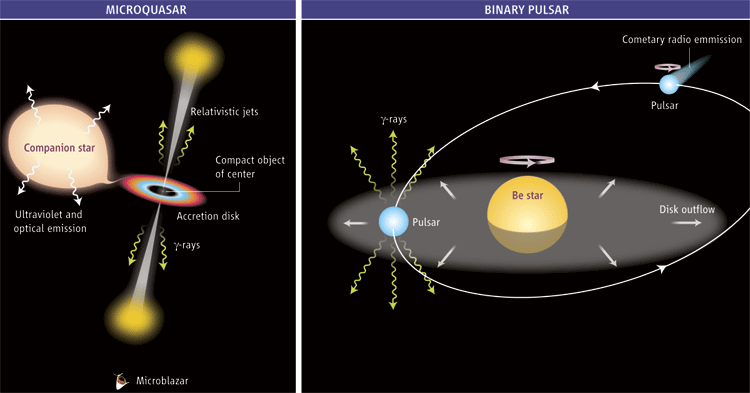Gamma-ray binaries
Gamma-ray binaries are composed of a massive star and a compact object. Gamma-ray binaries have been detected from radio up to TeV gamma-rays but most of their emission is radiated in the 1-1000 MeV band, hence their name. Five systems are currently known but their Galactic population could reach several 100s. MeV observations offer the best chance to find such systems, otherwise inconspicuous at other wavelengths. Their emission from radio to VHE is variable along the orbit. Periodic MeV emission has been recently reported from one COMPTEL source, in phase with the X-ray and TeV gamma-ray emission but in anti-phase with emission in the GeV range. The variability lightcurve and the spectral shape in the MeV domain provide information on the origin of the accelerated particles, the efficiency of the acceleration process, and the amplitude of the magnetic field. Gamma-ray binaries are thought to be powered by the spin-down of a young pulsar, whose relativistic wind interacts with the stellar wind of its stellar wind on spatial scales much smaller than in pulsar wind nebulae. Gamma-ray binaries offer novel ways to probe pulsar physics and, more generally, to study the formation of relativistic outflows from highly-magnetized, rotating objects.
Required instrument performances:
 Two models of binary star systems emitting gamma rays. Left: a microquasar with a stellar-mass black hole accreting material from a massive companion star. Right: a binary system with a pulsar and a Be star. Credit: F. Mirabel. |
Required instrument performances:
| Performance parameter | Goal value | Remarks and notes |
|
Field-of-view (FWHM, deg) |
~1 sr | perform monthly scans of Galactic Plane to search for new binaries (variable sources). |
|
Angular resolution (FWHM, deg) |
0.1 – 0.5 | 0.1 deg to allow identification of counterpart in other wavelengths. 0.5 deg is enough if the identification is left to follow-up observations in very-high energy (VHE) gamma-rays (assuming all are VHE sources). |
|
Spectral resolution (ΔE/E @ Energy) |
||
|
Line sensitivity (@ Energy) (cm-2 s-1, 3σ, 1 Ms) |
||
|
Continuum sensitivity (in which energy band?) (cm-2 s-1 keV-1, ΔE=E, 3σ, 1 Ms) |
1 – 100 MeV range 10-9 cm-2 s-1 keV-1 @ 1 MeV |
Comparable to Fermi/LAT sensitivity in a nu Fnu plot. |
| Timing performances |
|
Periodic signal expected on orbital timescale (days-months). |
|
Polarimetric capability (Minimum Polarization Fraction for a Crab source in 1 Ms) |
|
Might have variable, periodic polarisation. |
| Real-time data? |
 AstroMeV
AstroMeV